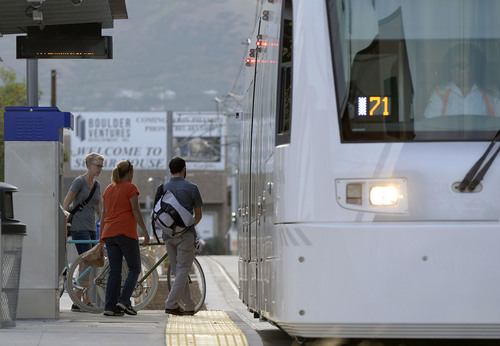This is an archived article that was published on sltrib.com in 2014, and information in the article may be outdated. It is provided only for personal research purposes and may not be reprinted.
Before uttering the word "streetcar" in Salt Lake City, it's best to hold on tight — it's a topic that promises a rough ride.
In a dramatic 4-3 split vote Tuesday evening, the City Council approved an additional $3 million as a match for federal funding that would extend the Sugar House Streetcar line.
It passed despite harsh criticism of the Utah Transit Authority — which operates the line — by several council members who said UTA has undermined the success of the streetcar by not scheduling it as intended.
East side council members Charlie Luke and Lisa Adams said they have had an earful from their constituents on the streetcar and the general topic of mass transit — or lack thereof.
They weren't exactly all smiles Tuesday evening when it came to coughing up another $3 million as part of a match for a $10.4 million federal (TIGER) grant to extend the line east to Highland Drive and then south to 2100 South.
The city's match also includes an already budgeted $1.5 million, bringing its total match to $4.5 million.
Luke voted for the funding along with council members Erin Mendenhall, Stan Penfold and Kyle LaMalfa. Voting against were Adams, Luke Garrott and James Rogers.
Unlike UTA's TRAX and bus service, the Sugar House Streetcar — or S Line — is a joint project with the UTA.
Although some Salt Lake City neighborhoods lack adequate bus service, the city and UTA opened the Sugar House Streetcar from the TRAX Central Station at 2100 South and 200 West to 2250 McClelland Ave. (1050 East) in December. Price tag: $37 million.
But ridership has been significantly less than projected.
Luke, the council chairman, said although he would vote for the S Line extension to 2100 South and Highland Drive, he would not support construction of further segments until there is a comprehensive transportation plan.
"A lot of questions are being asked by our constituents," he said. "And we can't answer those questions" he said pointing to the faulty projections and a lack of bus routes.
By mid-October, officials should know if the TIGER grant will be awarded to Salt Lake City. Construction could begin by late 2016.
Mayor Ralph Becker championed the extension and lauded the UTA for receiving national awards for its transit service. "We've got to move forward," he told the council.
But Luke wasn't buying it. "Those who give UTA national awards come from people who don't ride UTA," he quipped.
The problem, among others, said Adams, is that the S Line doesn't run frequently enough or late enough each day to adequately serve Sugar House residents.
"Without a commitment from UTA to extend those hours," she said, "I don't know if I want to allocate more money for more track if it's not going to be used."
But Councilwoman Mendenhall said extending the line to the heart of Sugar House will put "a head on the body" and make a much better line with more ridership. The line can't live up to expectations without the extension, she said.
Beyond that, about 1,000 new apartments and condominiums will soon open in Sugar House, said transportation director Robin Hutcheson. Ridership should dramatically increase, she said.
Hutcheson added that the S Line is part of what will be part of a future-looking network that would give mass transit riders many choices. A citywide transportation master plan is expected sometime next summer.
The Sugar House Streetcar extension as now envisioned would run along both sides of Highland Drive in the outer traffic lanes with stops at curbside. It will extend to the Sugar House Monument Plaza now under construction. The plaza is planned to open in December.







